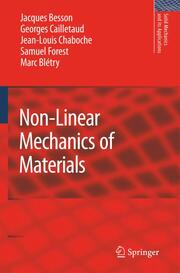Detailansicht
Non-Linear Mechanics of Materials
Solid Mechanics and Its Applications 167
Besson, Jacques/Cailletaud, Georges/Chaboche, Jean-Louis et al
ISBN/EAN: 9789048133550
Umbreit-Nr.: 1572731
Sprache:
Englisch
Umfang: xviii, 433 S.
Format in cm:
Einband:
gebundenes Buch
Erschienen am 16.12.2009
Auflage: 1/2010
- Zusatztext
- InhaltsangabePreface by Jean Lemaitre Chapter 1 Introduction 1.1. Model construction 1.2. Applications to models Chapter 2 General concepts 2.1. Formulation of the constitutive equations 2.2. Principle of virtual power 2.3. Thermodyna~nicso f irreversible processes 2.4. Main class of constitutive equations 2.5. Yield criteria 2.6. Numerical methods for nonlinear equations 2.7. Numerical solution of differential equations 2.8. Finite element Chapter 3 Plasticity and 3D viscoplasticity 3.1. Generality 3.2. Formulation of the constitutive equations 3.3. Flow direction associated to the classical criteria 3.4. Expression of some particular constitutive equations in plasticity 3.5. Flow under prescribed strain rate 3.6. Nonassociated plasticity 3.7. Nonlinear hardening 3.8. Some classical extensions 3.9. Hardening and recovery in viscoplasticity 3.10. Multimechanism models 3.1 1. Behaviour of porous materials Chapter 4 Introduction to damage mechanics 4.1. Introduction 4.2. Notions and general concepts 4.3. Damage variables and state laws 4.4. State and dissipative couplings 4.5. Damage deactivation 4.6. Damage evolution laws 4.7. Examples of damage models in brittle materials Chapter 5 Microstructural mechanics 5.1. Characteristic lengths and scales in microstructural mechanics 5.2. Some homogenization techniques 5.3. Application to linear elastic heterogeneous materials 5.4. Some examples. applications and extensions 5.5. Homogenization in thermoelasticity 5.6. Nonlinear homogenization 5.7. Computation of RVE 5.8. Homogenization of coarse grain structures Chapter 6 Finite deformations 6.1. Geometry and kinematics of continuum 6.2. Sthenics and statics of the continuum 6.3. Constitutive laws 6.4. Application: Simple glide 6.5. Finite deformations of generalized continua Chapter 7 Nonlinear structural analysis 7.1. The material object 7.2. Examples of implementations of particular models 7.3. Specificities related to finite elements Chapter 8 Strain localization 8.1. Bifurcation modes in elastoplasticity 8.2. Regularization methods Appendix Notation used A.1. Tensors A.2. Vectors, Matrices A.3. Voigt notation
- Kurztext
- There currently exists a significant gap between materials models used by engineers and the ones available in research laboratories. Knowledge transfer must be facilitated by software development and databases, but also by information and teaching. From that perspective, Nonlinear Mechanics of Materials offers an update of the knowledge necessary to understand and use the most recent models of materials behavior and damage in structures. After presenting numerical tools, and classical plasticity and viscoplasticity, this work provides a description of damage mechanics, heterogeneous materials mechanics, finite strain, nonlinear structural analysis and strain localization phenomena, by seeking equilibrium between a theoretical approach and real materials models.
- Schlagzeile
- InhaltsangabePreface by Jean Lemaitre Chapter 1 Introduction 1.1. Model construction 1.2. Applications to models Chapter 2 General concepts 2.1. Formulation of the constitutive equations 2.2. Principle of virtual power 2.3. Thermodyna~nicso f irreversible processes 2.4. Main class of constitutive equations 2.5. Yield criteria 2.6. Numerical methods for nonlinear equations 2.7. Numerical solution of differential equations 2.8. Finite element Chapter 3 Plasticity and 3D viscoplasticity 3.1. Generality 3.2. Formulation of the constitutive equations 3.3. Flow direction associated to the classical criteria 3.4. Expression of some particular constitutive equations in plasticity 3.5. Flow under prescribed strain rate 3.6. Non-associated plasticity 3.7. Nonlinear hardening 3.8. Some classical extensions 3.9. Hardening and recovery in viscoplasticity 3.10. Multimechanism models 3.1 1. Behaviour of porous materials Chapter 4 Introduction to damage mechanics 4.1. Introduction 4.2. Notions and general concepts 4.3. Damage variables and state laws 4.4. State and dissipative couplings 4.5. Damage deactivation 4.6. Damage evolution laws 4.7. Examples of damage models in brittle materials Chapter 5 Microstructural mechanics 5.1. Characteristic lengths and scales in microstructural mechanics 5.2. Some homogenization techniques 5.3. Application to linear elastic heterogeneous materials 5.4. Some examples. applications and extensions 5.5. Homogenization in thermoelasticity 5.6. Nonlinear homogenization 5.7. Computation of RVE 5.8. Homogenization of coarse grain structures Chapter 6 Finite deformations 6.1. Geometry and kinematics of continuum 6.2. Sthenics and statics of the continuum 6.3. Constitutive laws 6.4. Application: Simple glide 6.5. Finite deformations of generalized continua Chapter 7 Nonlinear structural analysis 7.1. The material object 7.2. Examples of implementations of particular models 7.3. Specificities related to finite elements Chapter 8 Strain localization 8.1. Bifurcation modes in elastoplasticity 8.2. Regularization methods Appendix Notation used A.1. Tensors A.2. Vectors, Matrices A.3. Voigt notation
